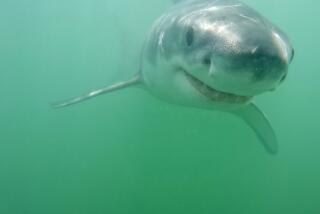This sea world puts on a whale of a show
The first dolphins arrive like pointy-nosed escorts sent to guide the Monte Carlo to some enchanted mammalian universe.
They ride bow waves and leap high on both sides of the 75-foot vessel, seemingly trying to better glimpse the people, who are crammed at the foredeck trying to get a better glimpse.
As one wave falls back, others emerge from a pod perhaps 3,000 strong, in an acrobatic display that lasts nearly an hour.
“These are long-beaked common dolphins,” a naturalist exclaims over the loudspeaker. “They are common to this area, and while it is common for them to appear in large numbers, it is uncommon for there to be this many of them.”
The presence of so many dolphins is, if nothing else, a glorious omen, for as the boat nears and slowly rounds the west end of Santa Catalina Island, new and larger species of mammals continually surface to show the way.
Their abundance is astonishing, creating an impression that all is idyllic in their blue realm.
Of course, that is not true.
The U.S. Navy is being sued over its plans to employ high-intensity sonar bursts during training exercises.
The sophisticated systems, also utilized by military forces elsewhere in the world, have been linked to death and debilitation among whales and other mammals.
Japan still slaughters dolphins for human consumption, and is among nations that still hunt whales.
Pollution and global warming are other disconcerting issues. So is the sad reality that far fewer children these days -- because of shrinking field-trip budgets and standardized curriculums -- are being introduced to the marine environment.
But such concerns on this uncommonly flat-calm Saturday are pushed to the background by mighty leviathan breaths and a steady protuberance of fins and flukes.
Clearly, although proceeds of this “Ultimate Whale Watch” adventure may benefit the wild animals, the day belongs to those who have come to watch them.
*
The Monte Carlo shoves off from its San Pedro dock with 80 passengers. Many are members of the American Cetacean Society’s Los Angeles chapter, which offers seasonal day trips during prime viewing periods.
This excursion, planned by Diane and Bernardo Alps, coincides with the peaking northbound gray whale migration, so expectations soar.
Sea lions perched atop a large green buoy eye the vessel warily as it glides by. Gulls soar erratically overhead.
Beyond the breakwater, a vast gray ocean unfolds and Todd McGrath spots the head of a northern elephant seal, bobbing like a giant cork in the distance.
A small pod of short-beaked common dolphins breezes by and Alisa Schulman-Janiger, the designated naturalist, talks about this species and others that might be encountered.
She’s eventually silenced, however, by the distant sight of a peculiar blue line across the horizon.
Capt. Karl Smith confirms her suspicion. “Dolphins,” he says. “Lots of them.”
The long-beaked common dolphins are churning the ocean during a feeding spree beneath hundreds of frenzied gulls.
Beyond them, near the island, the towering spout of a fin whale wafts in the breeze.
To the west, several Risso’s dolphins -- their chalk-white bodies luminous beneath the surface -- allow a rare and lengthy close approach.
Behind the island, two plumes reveal an adult and juvenile gray whale, heading leisurely northward.
McGrath claims to have spotted humpback whales breaching in the distance.
Sunshine bursts through the clouds and the enchanted universe produces more life when dozens of Dall’s porpoise surface in scattered sub-pods.
These robust, orca-colored mammals are typically hyperactive and elusive, capable of 55-mph bursts, but not on this day.
The abundance and closeness of all of these sea creatures borders on the absurd.
“Their behaviors are so gorgeous; you never get tired of it,” says Bobbie Hedges, a Manhattan Beach resident wearing killer-whale earrings and a whale-fluke pendant.
McGrath spots four bottlenose dolphins, but Smith stays with the porpoise pack, while being urged to seek the presumed humpbacks.
At least four more gray whales surface, further confusing the captain. Another northern elephant seal pokes through, as if to inspect the source of so much topside commotion.
The situation is now beyond absurd.
“It just goes to show that the ocean is full of life, which is quite the opposite of what many people are saying,” says Danny Strunk, the co-captain, in reference to environmentalists’ cries that the oceans are dying.
Suddenly, four humpback whales materialize and veer in different directions. A showing of tail flukes generates an eruption of camera shutters.
Smith follows two and Schulman-Janiger identifies one as a type-4 adult, with a black fluke blotched with white, and the other as a type-5 juvenile (all-black fluke).
Yet another elephant seal surfaces, and a lone gray whale appears in the distance.
But it’s time to go home, and as the vessel swerves toward the mainland, one of the humpbacks arches its back and begins a deep dive, lifting its fluke high into the air, as if waving goodbye.
More to Read
Sign up for The Wild
We’ll help you find the best places to hike, bike and run, as well as the perfect silent spots for meditation and yoga.
You may occasionally receive promotional content from the Los Angeles Times.






